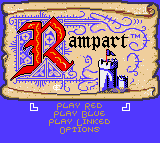 |
 |
Rampart |
The goal in Rampart is to defend your castle from invading troops. After selecting your castle and placing your cannons, ocean going ships will attempt to land on your shores. You must blast the ships before they land otherwise you will have to contend with the ground troops who will destroy your castle.
The puzzle aspect of Rampart appears when you must rebuild your castle walls. Tetris-like pieces will appear and you must place them so that they mend the castle walls that were bombarded by the invading ships. The problem is that the pieces don't always fit, so you will have to use your noodle to figure out how to surround your castle. Should you fail in this and leave your castle open to invaders, the game will be over.
One thing that made Rampart stand out in the arcade was the fact that some units used a trak-ball. There have been other variations that used joysticks, but I'm guessing this was the last arcade game to ever use a trak-ball. The ball is used to maneuver your cursor around the screen to either aim your cannons at the enemy, rebuild your castle walls, or place new cannons within your castle.
Of course, the Lynx does not have a trak-ball, so it had to make due with the joypad. And it does so admirably, however, losing the ability to control the speed of the cursor is limited. Pressing the button will double the speed of the cursor, but that makes it easy to lose control and you can find yourself overshooting your targets more often than with a trak-ball.
One stage is benefited by the use of the joypad is the castle rebuilding stage. In the arcade, you must be precise where you place the pieces. However on the Lynx version, one tap of the pad will adjust the piece on the "checkerboard" grid perfectly. This makes it easier to place multiple pieces on the board quickly.
The graphics in the arcade version of Rampart were sparse so you won't be knocked over by the Lynx version either. They get the job done and this is yet another faithful conversion to the tiny Lynx screen. The graphics do shine however in the intermission screens and the opening title as you see the horseman ride to his castle to warn of the invaders. There is some nice animation in the rider!
The sound is faithful to the arcade as well. The cannon fire sound like cannon fire and the explosions sound like explosions. The real sound treats from Rampart are from the voice and music. The two samples lifted from the arcade, "Ready! Aim! Fire!" and "Cease fire!" sound excellent. And the music, while a bit tinny, gives the game the military atmosphere needed. I'm just not 100% convinced that the percussion I'm hearing is a drum.
Gameplay, in a word, is FRANTIC! There is no time to think when playing Rampart. You have only have a few sparse moments to rebuild your castle and even fewer moments to attack the invaders. I just wish there were 3 more seconds to attack those ships, especially since I've already spent so much time perfecting my castle!
Different enemy ships add an element of strategy to the blasting stage. Brown ships are the easiest and take only two cannon hits to sink. Green ships take 3 hits, grey ships take 5 hits. The red ships are the most evil of all because not only do they take 5 hits to sink, but they fire red cannonballs at you. When these red cannonballs strike your castle walls, a fire burns there that cannot be put out. This forces you to rebuild around these fires making your job rebuilding much more complex.
Another element of interest is the ground troops. Once a ship lands unfettered, an army pops out and advances on your castle. If you do not have protection, they will make the rebuilding process more difficult. In addition, if they can somehow reach the "heart" or center of the castle, they will destroy it and your game will be over.
Rampart is a great game that sometimes gets overlooked on the Lynx. In terms of arcade to home translations, the Lynx version is one of the best, if not the best.
If you need some help winning games in Rampart, be sure to read TAT's Rampart Strategy Guide.

 On my quest to play every version of Rampart, I was stunned to learn that the authors of the Gameboy version appear to have taken graphics directly from the Lynx version! (Lynx on right, GB on left.)
On my quest to play every version of Rampart, I was stunned to learn that the authors of the Gameboy version appear to have taken graphics directly from the Lynx version! (Lynx on right, GB on left.)The flashing logo in the included graphic is Susan G. McBride's special "signature" and is proof she designed the image. And it doesn't appear that SGM got any credit in the GB game for designing these graphics.
There are a few minor changes like the addition of the tower, a few (lame looking) curly-Qs, and a change to the inner and lower parts of the "R." Also, the cinema screens from the Lynx version appear to be lifted too. Makes you wonder, doesn't it?
| Name: | |
| Subject: | |
| Comment: | |
| Check: | What is the greatest video game company of all time? (Hint: Atari.) |